Amana hejiaqingii (Liliaceae), a New Species from the Dabie Mountains, China
Abstract
1. Introduction
2. Materials and Methods
2.1. Sampling, Sequencing and Assembly
2.2. Morphological Observation and Principal Coordinates Analysis
2.3. Cytological Analysis
2.4. Phylogenetic Analyses
3. Results
3.1. Morphological Comparisons
3.2. Principal Coordinates Analysis
3.3. Cytology Observation
3.4. Molecular Phylogeny
4. Taxonomy
| 1. Bracts usually two, opposite. | 2 |
| 1. Bracts usually three, verticillate, or not verticillate (in this case degraded). | 3 |
| 2. Lower leaves linear; flowers 1–5; anthers yellow at maturity (before releasing pollens). | Amana edulis |
| 2. Lower leaves oblanceolate; flower mostly solitary, sometimes two; anthers purple at maturity (before releasing pollens). | Amana nanyueensis |
| 3. Bracts usually not verticillate, degraded, 1–5 mm long. | Amana wanzhensis |
| 3. Bracts verticillate, not degraded, longer than 1.2 cm. | 4 |
| 4. Lower leaves linear, or linear to oblanceolate in the same population, always with a broad white band along the midvein above. | 5 |
| 4. Lower leaves oblong or oblanceolate, sometimes with white veins or midvein, but not a broad white band. | 6 |
| 5. Leaves green, linear, 0.4–1 cm wide; purple-red on the back of outer tepals. | Amana baohuaensis |
| 5. Leaves green or brownish-green to purple, linear to oblanceolate, 1–2 cm wide; purple-red streaks on the back of outer tepals. | Amana latifolia |
| 6. Anthers purple at maturity (before releasing pollens). | 7 |
| 6. Anthers yellow at maturity (before releasing pollens). | 8 |
| 7. Leaves green, with several white veins; bulb tunic sparsely villous in-side. | Amana anhuiensis |
| 7. Leaves green, dark-green or purplish-green, without white veins; bulb tunic glabrous inside. | Amana kuocangshanica |
| 8. Leaves oblong; bulb tunic densely villous-woolly inside. | Amana erythronioides |
| 8. Leaves oblanceolate; bulb tunic glabrous or sparely villous inside. | 9 |
| 9. Flowers pink, solitary. | Amana hejiaqingii |
| 9. Flowers white, mostly solitary, sometimes two. | Amana tianmuensis |
Supplementary Materials
Author Contributions
Funding
Institutional Review Board Statement
Informed Consent Statement
Data Availability Statement
Acknowledgments
Conflicts of Interest
References
- Tan, D.Y.; Zhang, Z.; Li, X.R.; Hong, D.Y. Restoration of the genus Amana Honda (Liliaceae) based on a cladistic analysis of morphological characters. Acta Phytotax. Sin. 2005, 43, 262–270. [Google Scholar] [CrossRef]
- Ohwi, J.; Kitagawa, M. New Flora of Japan; Shibundo Co. Ltd.: Tokyo, Japan, 1992. [Google Scholar]
- Chen, X.Q.; Mordak, H.V. Tulipa Linnaeus. In Flora of China; Wu, Z.-Y., Raven, P.H., Eds.; Science Press: Beijing, China; Missouri Botanical Garden Press: St. Louis, MO, USA, 2000; Volume 24, pp. 123–126. [Google Scholar]
- Shen, X.S. A new species of Tulipa (Liliaceae) from China. Acta Bot. Yunnanica 2001, 23, 39–40. [Google Scholar] [CrossRef][Green Version]
- Tan, D.Y.; Li, X.R.; Hong, D.Y. Amana kuocangshanica (Liliaceae) a new species from south–east China. Bot. J. Linn. Soc. 2007, 154, 435–442. [Google Scholar] [CrossRef]
- Tan, D.Y.; Li, X.R.; Hong, D.Y. Neotypification and Additional Description of Amana anhuiensis (X.S. Shen) D.Y. Tan & D.Y. Hong (Liliaceae) from Anhui, China. Acta Bot. Boreal. Occid. Sin. 2008, 28, 0393–0395. [Google Scholar]
- Zhang, K.; Huang, L. Amana wanzhensis (Liliaceae), a new species from Anhui, China. Phytotaxa 2014, 177, 118–124. [Google Scholar] [CrossRef][Green Version]
- Li, P.; Lu, R.S.; Xu, W.Q.; Ohi-Toma, T.; Cai, M.Q.; Qiu, Y.X.; Fu, C.X.; MCameron, K. Comparative genomics and phylogenomics of East Asian Tulips (Amana, Liliaceae). Front. Plant Sci. 2017, 8, 451. [Google Scholar] [CrossRef]
- Wang, L.; Xing, Q.; Lu, G.Y.; Lu, X.; Zhao, Q.; Song, X.W.; Han, B.X. Amana baohuaensis (Liliaceae), a new species from East China. Phytotaxa 2019, 427, 43–50. [Google Scholar] [CrossRef]
- Wang, M.Z.; Fan, X.K.; Zhang, Y.H.; Wu, J.; Mao, L.M.; Zhang, S.L.; Cai, M.Q.; Li, M.H.; Zhu, Z.S.C.; Zhao, M.S.; et al. Phylogenomics and integrative taxonomy reveal two new species of Amana (Liliaceae). Pl. Diversity 2022. [Google Scholar] [CrossRef]
- Struik, G.J. Growth patterns of some native annual and perennial herbs in southern Wisconsin. Ecology 1965, 46, 401–420. [Google Scholar] [CrossRef]
- Wu, J.; Wang, M.Z.; Zhu, Z.S.C.; Cai, M.Q.; Lee, J.; Li, P. Cytogeography of the East Asian Tulips (Amana, Liliaceae). Taxonomy 2022, 2, 145–159. [Google Scholar] [CrossRef]
- Jin, J.J.; Yu, W.B.; Yang, J.B.; Song, Y.; de Pamphilis, C.W.; Yi, T.S.; Li, D.Z. GetOrganelle: A fast and versatile toolkit for accurate de novo assembly of organelle genomes. Genome. Biol. 2020, 21, 241. [Google Scholar] [CrossRef] [PubMed]
- Thiers, B.M.; Tulig, M.C.; Watson, K.A. Digitization of The New York Botanical Garden Herbarium. Brittonia 2016, 68, 324–333. [Google Scholar] [CrossRef]
- Wickham, H. Ggplot2: Elegant Graphics for Data Analysis; Springer: New York, NY, USA, 2016. [Google Scholar]
- Stebbins, G.L. Chromosomal Evolution in Higher Plants; Addison-Wesley: London, UK, 1971; pp. 87–93. [Google Scholar]
- Paszko, B. A critical review and a new proposal of karyotype asymmetry indices. Plant Syst. Evol. 2006, 258, 39–48. [Google Scholar] [CrossRef]
- Peruzzi, L.; Leitch, I.J.; Caparelli, K.F. Chromosome diversity and evolution in Liliaceae. Ann. Bot. 2009, 103, 459–475. [Google Scholar] [CrossRef]
- Peruzzi, L.; Eroğlu, H.E. Karyotype asymmetry: Again, how to measure and what to measure? Comp. Cytogen. 2013, 7, 1–9. [Google Scholar] [CrossRef] [PubMed]
- Peruzzi, L.; Altınordu, F. A proposal for a multivariate quantitative approach to infer karyological relationships among taxa. Comp. Cytogen. 2014, 8, 337. [Google Scholar] [CrossRef]
- Altınordu, F.; Peruzzi, L.; Yu, Y.; He, X.J. A tool for the analysis of chromosomes: KaryoType. Taxon 2016, 65, 586–592. [Google Scholar] [CrossRef]
- Lu, R.S.; Yang, T.; Chen, Y.; Wang, S.Y.; Cai, M.Q.; MCameron, K.; Li, P.; Fu, C.X. Comparative plastome genomics and phylogenetic analyses of Liliaceae. Bot. J. Linn. Soc. 2021, 196, 279–293. [Google Scholar] [CrossRef]
- Kearse, M.; Moir, R.; Wilson, A.; Stones-Havas, S.; Cheung, M.; Sturrock, S.; Buxton, S.; Cooper, A.; Markowitz, S.; Duran, C.; et al. Geneious Basic: An integrated and extendable desktop software platform for the organization and analysis of sequence data. Bioinformatics 2012, 28, 1647–1649. [Google Scholar] [CrossRef]
- Minh, B.Q.; Schmidt, H.A.; Chernomor, O.; Schrempf, D.; Woodhams, M.D.; von Haeseler, A.; Lanfear, R. IQ-TREE 2: New models and efficient methods for phylogenetic inference in the genomic era. Mol. Biol. Evol. 2020, 37, 1530–1534. [Google Scholar] [CrossRef]
- Kalyaanamoorthy, S.; Minh, B.Q.; Wong, T.K.F.; Haeseler Av Jermiin, L.S. ModelFinder: Fast model selection for accurate phylogenetic estimates. Nat. Methods 2017, 14, 587–589. [Google Scholar] [CrossRef] [PubMed]
- Ronquist, F.; Huelsenbeck, J.P. MrBayes 3: Bayesian phylogenetic inference under mixed models. Bioinformatics 2003, 19, 1572–1574. [Google Scholar] [CrossRef] [PubMed]

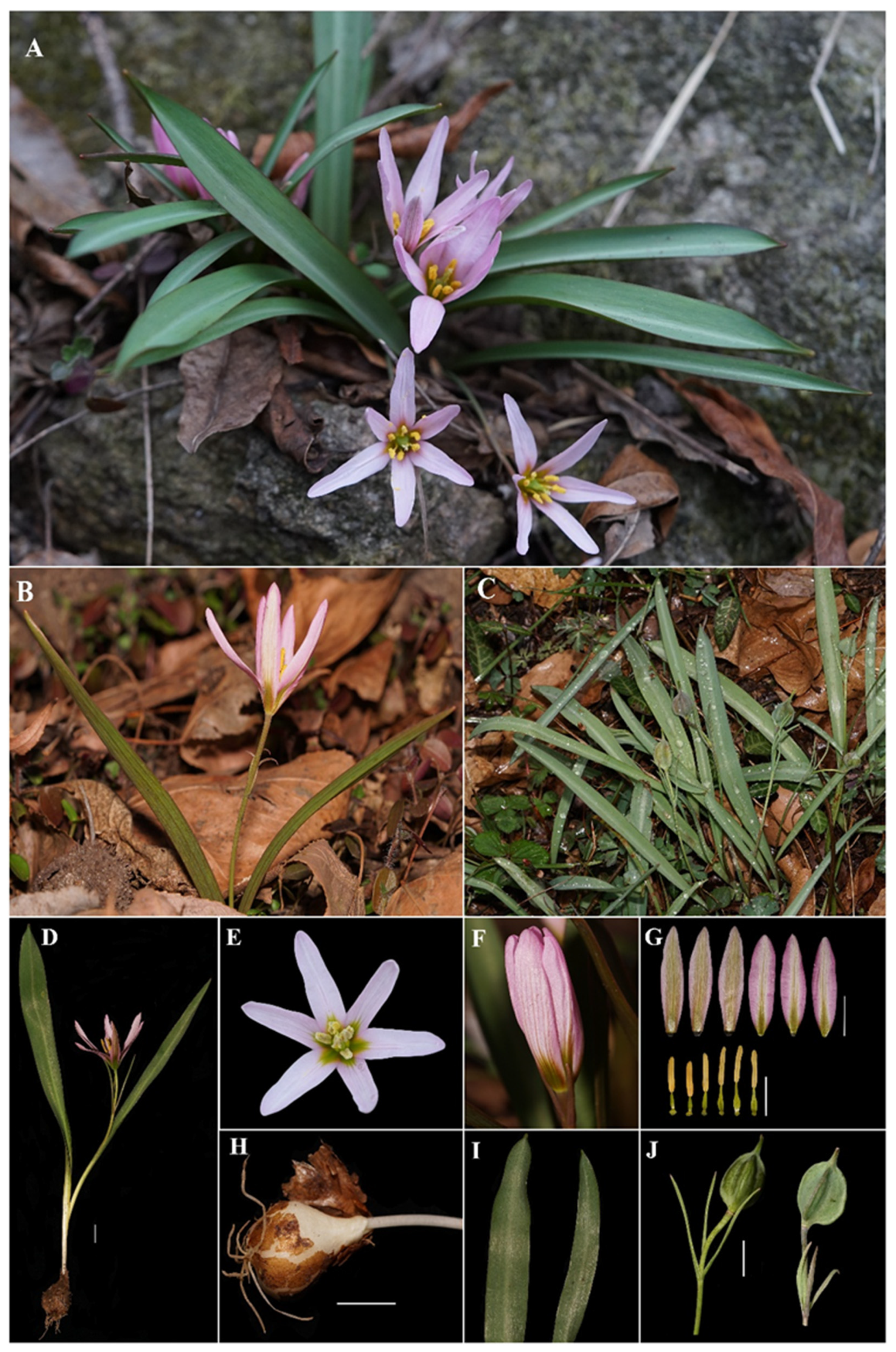
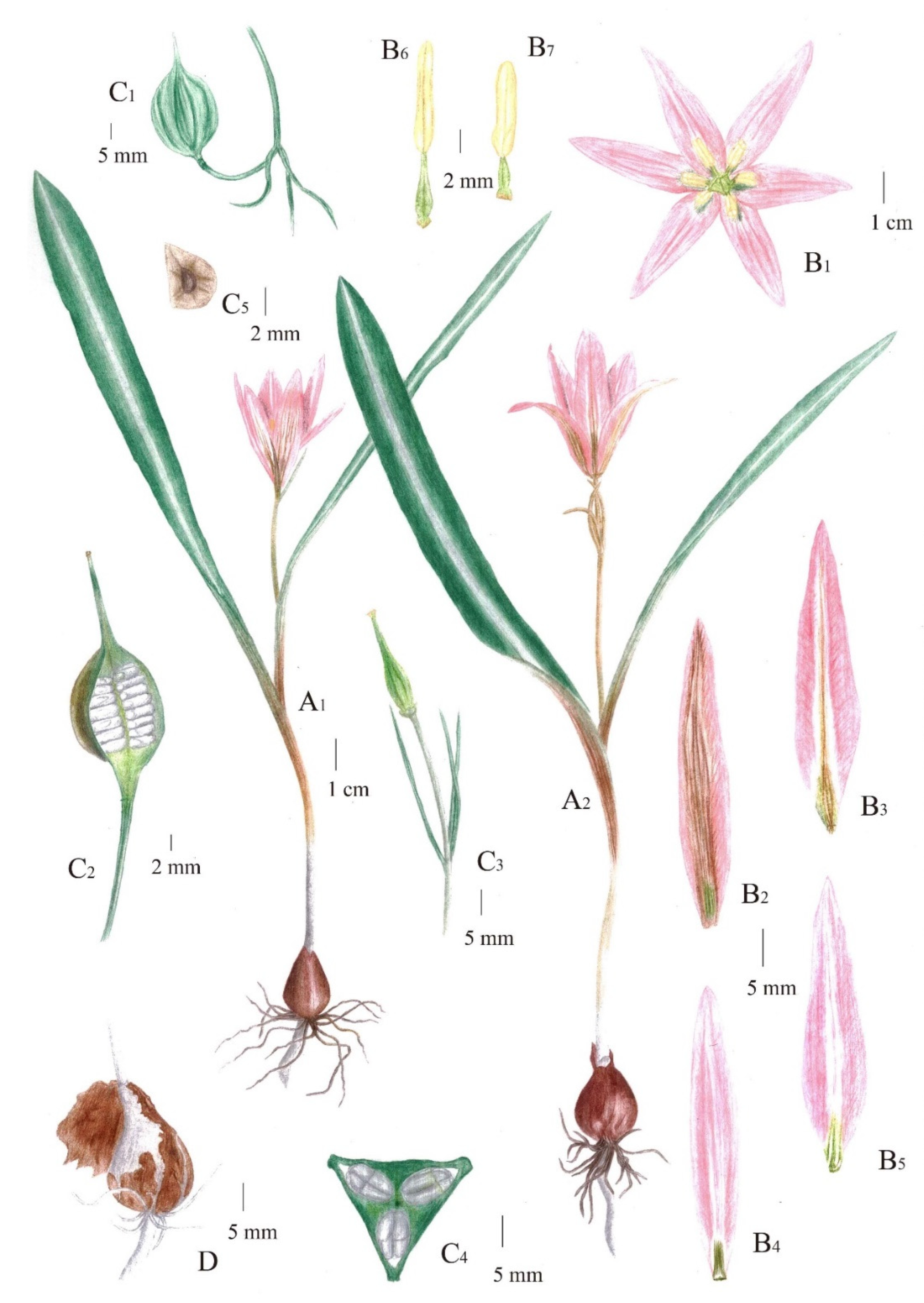
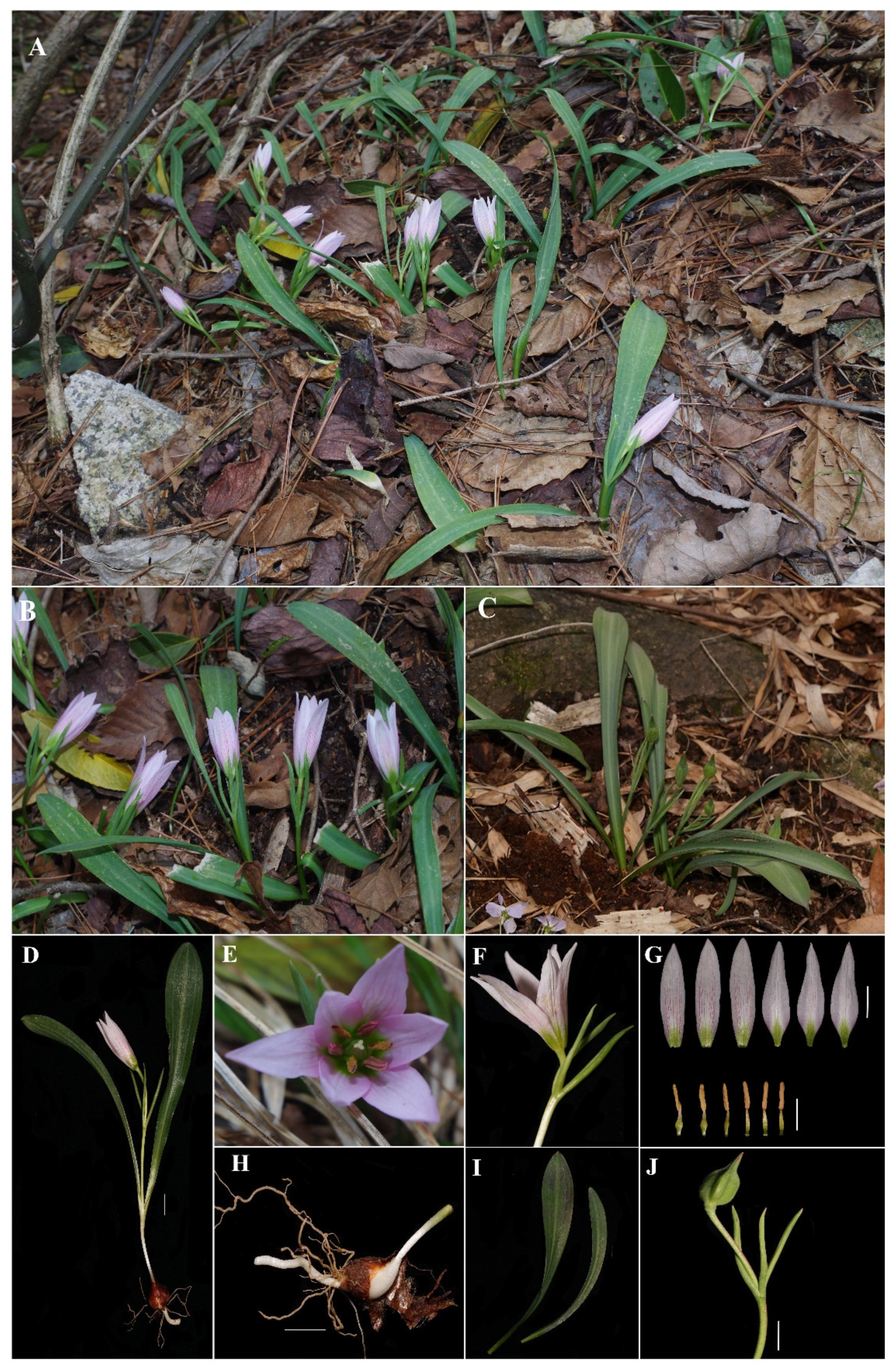

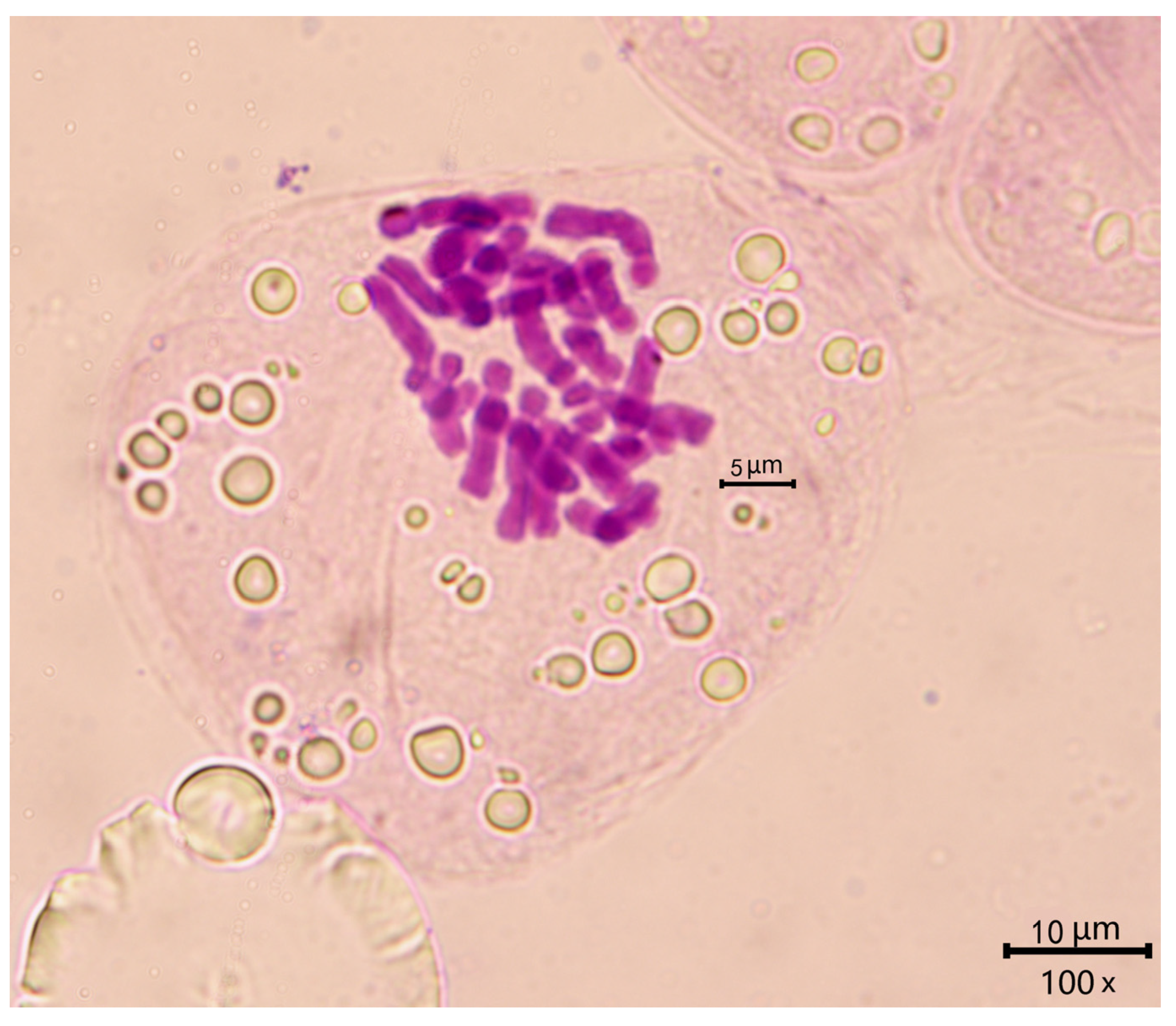
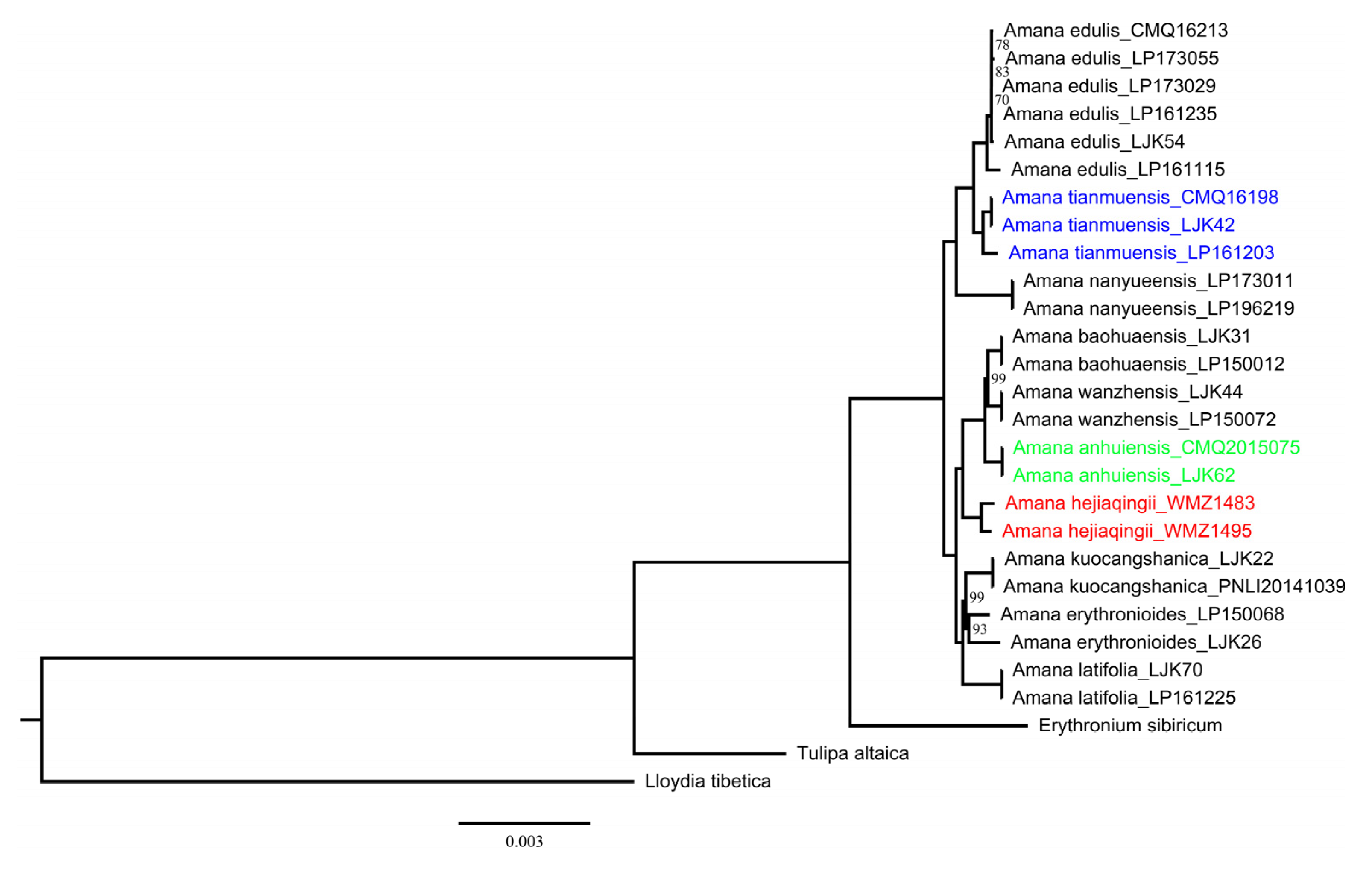
| Accession Name | Accession Number | Location |
|---|---|---|
| Amana anhuiensis_CMQ2015075-7 | KY401423 | Tianzhushan, Qianshan County, Anhui Province, China |
| Amana anhuiensis_LJK62-1 | MZ561649 | Tianzhushan, Qianshan County, Anhui Province, China |
| Amana baohuaensis_ LP150012 | MW929176 | Maoshan, Jurong City, Jiangsu Province, China |
| Amana baohuaensis_LJK31-1 | MZ561647 | Maoshan, Jurong City, Jiangsu Province, China |
| Amana hejiaqingii_WMZ1483 | ON764433 | Liluocheng, Shangcheng County, Xinyang City, Henan Province, China |
| Amana hejiaqingii_WMZ1495 | ON764434 | Feiyundong, Xisaishan District, Huangshi City, Hubei Province, China |
| Amana edulis_CMQ16213 | OL351567 | Xilin Temple, Jiujiang City, Jiangxi Province, China |
| Amana edulis_LJK54-1 | MW929177 | Yuxiang Village, Huangshan City, Anhui Province, China |
| Amana edulis_LP161115-1 | AB024388 | Hangzhou Botanical Garden, Hangzhou City, Zhejiang Province, China |
| Amana edulis_LP161235-1 | MW938051 | Daheishan, Dalian City, Liaoning Province, China |
| Amana edulis_LP173029 | OL351568 | Cheyu Valley, Zhouzhi County, Shaanxi Province, China |
| Amana edulis_LP173055 | OL351569 | Dushan, Nanyang City, Henan Province, China |
| Amana erythronioides_LP150068-4 | KY401421 | Simingshan, Yuyao City, Zhejiang Province, China |
| Amana erythronioides_LJK26-1 | MZ561646 | Simingshan, Yuyao City, Zhejiang Province, China |
| Amana kuocangshanica_PNLI20141039-1 | KY401426 | Kuocangshan, Linhai City, Zhejiang Province, China |
| Amana kuocangshanica_LJK22-1 | MZ561645 | Kuocangshan, Linhai City, Zhejiang Province, China |
| Amana latifolia_LJK70-1 | MZ561650 | Koshikawa Botanical Garden, Tokyo, Japan |
| Amana latifolia_LP161225-2 | KY401424 | Koishikawa Botanical Garden, Tokyo, Japan |
| Amana nanyueensis_LP173011-2 | MW876380 | Hengshan, Hengyang City, Huan Province, China |
| Amana nanyueensis_LP196219-1 | MW845753 | Hengshan, Hengyang City, Huan Province, China |
| Amana tianmuensis_LP161203-2 | MW876379 | Jinhuashan, Jinhua City, Zhejiang Province, China |
| Amana tianmuensis_LJK42-1 | MW876378 | Tianmushan, Lin’an City, Zhejiang Province, China |
| Amana tianmuensis_CMQ16198-1 | MW876377 | Tianmushan, Lin’an City, Zhejiang Province, China |
| Amana wanzhensis_LJK44-1 | MZ561648 | Xianxia Town, Ningguo City, Anhui Province, China |
| Amana wanzhensis_LP150072-11 | KY401422 | Xianxia Town, Ningguo City, Anhui Province, China |
| Erythronium sibiricum | NC_035681 | Xinjiang Province, China |
| Lloydia tibetica | MK673748 | Taibaishan, Mei County, Shaanxi Province, China |
| Tulipa altaica | NC_044780 | Tacheng, Urumqi, Xinjiang Province, China |
| Species | Amana anhuiensis | Amana hejiaqingii | Amana tianmuensis | |
|---|---|---|---|---|
| Characters | ||||
| Bulbs | Diameter | 1.13–1.72 cm | 0.93–2.3 cm | 0.7–1.8 cm |
| Tunics | yellowish-brown, thinly papery | yellowish-brown, thinly papery | yellowish-brown, thinly papery | |
| Inside | sparely villous | glabrous, sometimes sparely villous | glabrous, sometimes sparely villous | |
| Leaves | Color | green, with white veins | green, midvein grayish white | green |
| Shape | oblanceolate | oblanceolate | oblanceolate | |
| Lower-leaf length (LL) | 12.2–22.5 (17.05) cm | 8.0–33.9 (19.91) cm | 11.2–22.8 (16.5) cm | |
| Lower-leaf width (LW) | 1.7–2.6 (2.17) cm | 1.0–2.8 (1.71) cm | 0.9–2.5 (1.7) cm | |
| LL/LW | 5.5 < X < 10 | 6 < X < 20 | 5 < X < 14.5 | |
| Upper-leaf length (LL) | 11.0–21.4 (16.05) cm | 7.7–34 (19.47) cm | 9.5–23.4 (16.1) cm | |
| Upper-leaf width (LW) | 0.7–1.85 (1.16) cm | 0.5–1.4 (0.97) cm | 0.6–1.9 (1.2) cm | |
| LL/LW | 10 < X < 20 | 9 < X < 29.5 | 6.5 < X < 21 | |
| Bracts | 3, verticillate, narrowly lanceolate | 3, verticillate, linear | 3, verticillate, linear | |
| Bracts length | 2.8–4.7 (3.5) cm | 1.2–4.2 (2.6) cm | 1.8–3.5 (2.6) cm | |
| Pedicels | 2.2–5.1 cm | 0.5–4.1 cm | 1.1–5.6 cm | |
| Flowers | solitary; white or pink | solitary; pink | mostly solitary, sometimes two; white | |
| Tepals | Outer length | 2.9–4.3 (3.4) cm | 2.4–4.4 (3.4) cm | 1.8–3.4 (2.6) cm |
| Outer width | 0.4–0.6 (0.5) cm | 0.6–1.1 (0.8) cm | 0.4–0.9 (0.5) cm | |
| Inner length | 2.7–4.3 (3.3) cm | 2.1–3.9 (3.2) cm | 1.8–3.2 (2.4) cm | |
| Inner width | 0.7–1.2 (0.9) cm | 0.6–1.0 (0.8) cm | 0.4–1.1 (0.6) cm | |
| Anthers | light-purple | yellow | yellow | |
| Styles | 0.5–0.7 cm long | 0.4–0.6 cm long | 0.5–0.6 cm long | |
| Length of fruit beak | 0.5–1.0 cm long | 0.5–1.2 cm long | 0.45–1.1 cm long | |
Publisher’s Note: MDPI stays neutral with regard to jurisdictional claims in published maps and institutional affiliations. |
© 2022 by the authors. Licensee MDPI, Basel, Switzerland. This article is an open access article distributed under the terms and conditions of the Creative Commons Attribution (CC BY) license (https://creativecommons.org/licenses/by/4.0/).
Share and Cite
Wang, M.; Zhang, S.; Wu, J.; Zhu, X.; Liu, Z.; Lu, G.; Li, P. Amana hejiaqingii (Liliaceae), a New Species from the Dabie Mountains, China. Taxonomy 2022, 2, 279-290. https://doi.org/10.3390/taxonomy2030022
Wang M, Zhang S, Wu J, Zhu X, Liu Z, Lu G, Li P. Amana hejiaqingii (Liliaceae), a New Species from the Dabie Mountains, China. Taxonomy. 2022; 2(3):279-290. https://doi.org/10.3390/taxonomy2030022
Chicago/Turabian StyleWang, Meizhen, Shenglu Zhang, Jing Wu, Xinxin Zhu, Zongcai Liu, Gengyu Lu, and Pan Li. 2022. "Amana hejiaqingii (Liliaceae), a New Species from the Dabie Mountains, China" Taxonomy 2, no. 3: 279-290. https://doi.org/10.3390/taxonomy2030022
APA StyleWang, M., Zhang, S., Wu, J., Zhu, X., Liu, Z., Lu, G., & Li, P. (2022). Amana hejiaqingii (Liliaceae), a New Species from the Dabie Mountains, China. Taxonomy, 2(3), 279-290. https://doi.org/10.3390/taxonomy2030022






